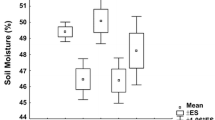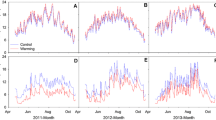Abstract
Identifying the plant traits and patterns of trait distribution in communities that are responsible for biotic regulation of CO2 uptake–climate responses remains a priority for modeling terrestrial C dynamics. We used remotely sensed estimates of gross primary productivity (GPP) from plots planted to different combinations of perennial grassland species in order to determine links between traits and GPP–climate relationships. Climatic variables explained about 50% of the variance in temporal trends in GPP despite large variation in CO2 uptake among seasons, years, and plots of differing composition. GPP was highly correlated with contemporary changes in net radiation (Rn) and precipitation deficit (potential evapotranspiration minus precipitation) but was negatively correlated with precipitation summed over 210 days prior to flux measurements. Plots differed in GPP–Rn and GPP–water (deficit, precipitation) relationships. Accounting for differences in GPP–climate relationships explained an additional 11% of variance in GPP. Plot differences in GPP–Rn and GPP–precipitation slopes were linked to differences in community-level light-use efficiency (GEE*). Plot differences in GPP–deficit slopes were linked to differences in a species abundance-weighted index of specific leaf area (SLA). GEE* and weighted SLA represent vegetation properties that may regulate how CO2 uptake responds to climatic variation in grasslands.



Similar content being viewed by others
References
Burnham KP, Anderson DR. 2002. Model selection and multimodel inference—a practical information-theoretic approach. 2nd edn. New York: Springer. p 488.
Cornelissen JHC, Lavorel S, Garnier E, Díaz S, Buchmann N, Gurvich DE, Reich PB, ter Steege H, Morgan HD, van der Heijden MGA, Pausas JG, Poorter H. 2003. A handbook of protocols for standardized and easy measurement of plant functional traits worldwide. Aust J Bot 51:335–80.
Craine JM, Nippert JB, Elmore AJ, Skibbe AM, Hutchinson SL, Brunsell NA. 2012. Timing of climate variability and grassland productivity. Proc Natl Acad Sci USA 109:3401–5.
Díaz S, Cabido M. 2001. Vive la difference: plant functional diversity matters to ecosystem processes. Trends Ecol Evol 16:646–55.
Díaz S, Lavorel S, de Bello F, Quétier F, Grigulis K, Robson TM. 2007. Incorporating plant functional diversity effects in ecosystem service assessments. Proc Natl Acad Sci USA 104:20684–9.
Gamon JA. 2015. Reviews and syntheses: optical sampling of the flux tower footprint. Biogeosciences 12:4509–23.
Garnier E, Cortez J, Billes G, Navas ML, Roumet C, Debussche M, Laurent G, Blanchard A, Aubry D, Bellmann A, Neill C, Toussaint JP. 2004. Plant functional markers capture ecosystem properties during secondary succession. Ecology 85:2630–7.
Graham MH. 2003. Confronting multicollinearity in ecological multiple regression. Ecology 84:2809–15.
Grime JP. 1998. Benefits of plant diversity to ecosystems: immediate, filter and founder effects. J Ecol 86:902–10.
Hui D, Luo Y, Katul G. 2003. Partitioning interannual variability in net ecosystem exchange between climatic variability and functional change. Tree Physiol 23:433–42.
Huryn AD, Benstead JP, Parker SM. 2014. Seasonal changes in light availability modify the temperature dependence of ecosystem metabolism in an arctic stream. Ecology 95:2826–39.
Jasoni RL, Smith SD, Arnone JAIII. 2005. Net ecosystem CO2 exchange in Mojave Desert shrublands during the eighth year of exposure to elevated CO2. Glob Change Biol 11:749–56.
Kergoat L, Lafont S, Arneth A, Le Dantec V. 2008. Nitrogen controls plant canopy light-use efficiency in temperate and boreal ecosystems. J Geophys Res 113(G04017):2008. doi:10.1029/2007/JG000676.
Li Z, Guo X. 2012. Detecting climate effects on vegetation in northern mixed prairie using NOAA AVHRR 1-km time-series NDVI data. Remote Sens 4:120–34.
Ma S, Baldocchi DD, Mambelli S, Dawson TE. 2011. Are temporal variations of leaf traits responsible for seasonal and inter-annual variability in ecosystem CO2 exchange? Funct Ecol 25:258–70.
Maseda PH, Fernández RJ. 2015. Growth potential limits drought morphological plasticity in seedlings from six Eucalyptus provenances. Tree Physiol 36:243–51.
Mason NWH, Mouillot D, Lee WG, Wilson JB. 2005. Functional richness, functional evenness and functional divergence: the primary components of functional diversity. Oikos 111:112–18.
Moran MS, Ponce-Campos GE, Huete A, McClaran MP, Zhang Y, Hamerlynck EP, Augustine DJ, Gunter SA, Kitchen SG, Peters DPC, Starks PJ, Hernandez M. 2014. Functional response of U.S. grasslands to the early 21st-century drought. Ecology 95:2121–33.
Mouillot D, Villéger S, Scherer-Lorenzen Mason NWH. 2011. Functional structure of biological communities predicts ecosystem multifunctionality. PLoS ONE 6:e17476.
Musavi T, Mahecha MD, Migliavacca M, Reichstein M, van de Weg MJ, van Bodegom PM, Bahn M, Wirth C, Reich PB, Schrodt F, Kattge J. 2015. The imprint of plants on ecosystem functioning: a data-driven approach. Int J Appl Earth Obs Geoinf 43:119–31.
Polley HW, Emmerich W, Bradford JA, Sims PL, Johnson DA, Saliendra NZ, Svejcar T, Angell R, Frank AB, Phillips RL, Snyder KA, Morgan JA. 2010a. Physiological and environmental regulation of interannual variability in CO2 exchange of rangelands in the western United States. Glob Change Biol 16:990–1002.
Polley HW, Emmerich W, Bradford JA, Sims PL, Johnson DA, Saliendra NZ, Svejcar T, Angell R, Frank AB, Phillips RL, Snyder KA, Morgan JA, Sanabria J, Mielnick PC, Dugas WA. 2010b. Precipitation regulates the response of net ecosystem CO2 exchange to environmental variation on United States rangelands. Rangel Ecol and Manag 63:176–86.
Polley HW, Frank AB, Sanabria J, Phillips RL. 2008. Interannual variability in carbon dioxide fluxes and flux-climate relationships on grazed and ungrazed northern mixed-grass prairie. Glob Change Biol 14:1620–32.
Polley HW, Phillips RL, Frank AB, Bradford JA, Sims PL, Morgan JA, Kiniry JR. 2011. Variability in light-use efficiency for gross primary productivity on Great Plains grasslands. Ecosystems 14:15–27.
Pfisterer AB, Schmid B. 2002. Diversity-dependent production can decrease the stability of ecosystem functioning. Nature 416:84–6.
Reich PB, Walters MG, Ellsworth DS. 1997. From tropics to tundra: global convergence in plant functioning. Proc Natl Acad Sci (USA) 94:13730–4.
Richardson AD, Hollinger DY, Aber JD, Ollinger SV, Braswell BH. 2007. Environmental variation is directly responsible for short- but not long-term variation in forest–atmosphere carbon exchange. Glob Change Biol 13:788–803.
Sala OE, Gherardi LA, Reichmann L, Jobbágy E, Peters D. 2012. Legacies of precipitation fluctuations on primary production: theory and data synthesis. Philos Trans R Soc B 367:3135–44.
Shao J, Zhou X, Luo Y, Li B, Aurela M, Billesbach D, Blanken PD, Bracho R, Chen J, Fischer M, Fu Y, Gu L, Han S, He Y, Kolb T, Li Y, Nagy Z, Niu S, Oechel WC, Pinter K, Shi P, Suyker A, Torn M, Varlagin A, Wang H, Yan J, Yu G, Zhang J. 2015. Biotic and climatic controls on interannual variability in carbon fluxes across terrestrial ecosystems. Agric For Meteorol 205:11–22.
Shipley B. 2000. Cause and correlation in biology: a user’s guide to path analysis, structural equations and causal inference. Cambridge: Cambridge University Press. p 317p.
Violle C, Navas M-L, Vile D, Kazakou E, Fortunel C, Hummel I, Garnier E. 2007. Let the concept of trait be functional!. Oikos 116:882–92.
Wagle P, Xiao X, Scott RL, Kolb TE, Cook DR, Brunsell N, Baldocchi DD, Basara J, Matamala R, Zhou Y, Bajgain R. 2015. Biophysical controls on carbon and water vapor fluxes across a grassland climatic gradient in the United States. Agric For Meteorol 214–215:293–305.
Wang J, Rich PM, Price KP. 2003. Temporal responses of NDVI to precipitation and temperature in the central Great Plains, USA. Int J Remote Sens 24:2345–64.
Wardle DA, Bardgett RD, Callaway RM, Van der Putten WH. 2011. Terrestrial ecosystem responses to species gains and losses. Science 332:1273–7.
Wilsey BJ, Daneshgar PP, Hofmockel K, Polley HW. 2014. Invaded grassland communities have altered stability-maintenance mechanisms but equal stability compared to native communities. Ecol Lett 17:92–100.
Wilsey BJ, Daneshgar PP, Polley HW. 2011. Biodiversity, phenology and temporal niche differences between native- and novel exotic-dominated grasslands. Perspect Plant Ecol Evol Syst 13:265–76.
Wilsey BJ, Teaschner TB, Daneshgar PP, Isbell FI, Polley HW. 2009. Biodiversity maintenance mechanisms differ between native and novel exotic-dominated communities. Ecol Lett 12:432–42.
Wu D, Zhao X, Liang S, Zhou T, Huang K, Tang B, Zhao W. 2015. Time-lag effects of global vegetation responses to climate change. Glob Change Biol 21:3520–31.
Wu J, van der Linden L, Lasslop G, Carvalhais N, Pilegaard K, Beier C, Ibrom A. 2012. Effects of climate variability and functional changes on the interannual variation of the carbon balance in a temperate deciduous forest. Biogeosciences 9:13–28.
Acknowledgements
Field and laboratory assistance from Katherine Jones and Chris Kolodziejczyk was invaluable. This work was partially funded by the USDA-NIFA via Grant 2014-67003-22067. Mention of trade names or commercial products does not imply endorsement by the US Department of Agriculture. USDA is an equal opportunity provider and employer.
Author information
Authors and Affiliations
Corresponding author
Additional information
Author contributions
HWP conceived the study and analyzed data; AEG, PAF, BJW, and HWP collected data and participated in writing the manuscript.
Electronic supplementary material
Below is the link to the electronic supplementary material.
10021_2016_9_MOESM1_ESM.tif
Supplemental Fig. 1. Structural equation modeling was used to assess direct and indirect effects of vegetation properties on slopes of gross primary productivity-precipitation deficit (GPP-deficit) regressions for grassland plots of differing species composition (χ2 = 0.005, P = 0.94, df = 1). The GPP-deficit slope was regulated by community-weighted means of specific leaf area (SLA) via both a direct pathway and indirect pathways through community-weighted means of specific leaf N (SLN) and 3-year average of the seasonal maximum of community GPP (GPPmax). Standardized coefficients are listed beside each path. Supplementary material 1 (TIFF 137 kb)
Rights and permissions
About this article
Cite this article
Polley, H.W., Gibson, A.E., Fay, P.A. et al. Biotic Regulation of CO2 Uptake–Climate Responses: Links to Vegetation Properties. Ecosystems 19, 1376–1385 (2016). https://doi.org/10.1007/s10021-016-0009-8
Received:
Accepted:
Published:
Issue Date:
DOI: https://doi.org/10.1007/s10021-016-0009-8




